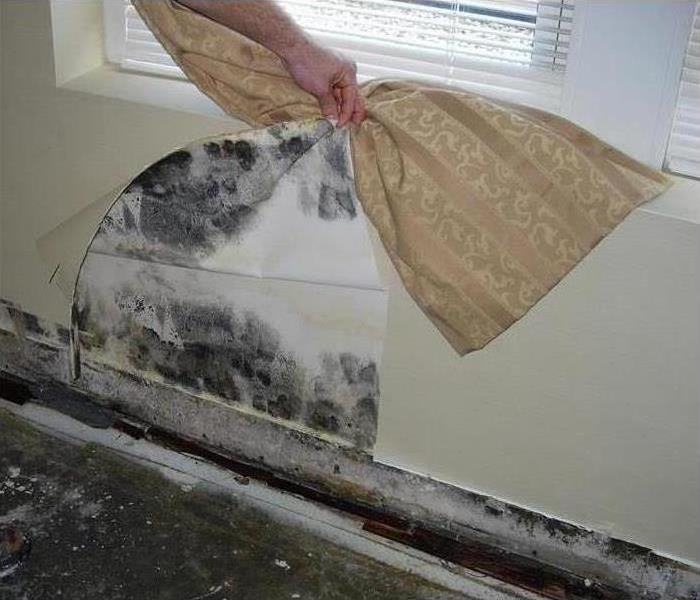What's Behind That Wallpaper?
11/19/2019 (Permalink)
 Look closely. the wallpaper looks as though it is in decent shape. As it peeled away from the wall it revealed the scope of the mold problem
Look closely. the wallpaper looks as though it is in decent shape. As it peeled away from the wall it revealed the scope of the mold problem
A home owner or business owner wants to get back to normal as soon as possible. Working to make that happen is our goal. That being said, water damage or fire damage is never a pretty thing. The right expectations need to be understood. Beyond that what needs to be understood is the reason for the time frame and process.
Let me explain. All too often especially with water damage issues we are asked to cease and desist. Pack up our stuff and leave before the work is done. There are even times that we recommend opening a wall, or pulling up the floor. Home owners and business owners will refuse to let us to do this sort of work. Why would they do that you ask. There are many reasons but the main one is that they do not want the inconvenience of more intrusion into their home. This is always a bad idea.
Restoration companies have extensive training and certifications that most do not. They also have years of experience working with insurance companies and property adjusters. This leads to a great understanding of the scope of work that is needed to properly mitigate your building. This ensures what they call secondary damage is not an option.
First let us get into what secondary damage is. Secondary damage is something that would not have happened even if the first occurred. Let me explain. If you do have a pipe break, you call and get the plumber out and stop the water. Moisture damage is what happens when you do not mitigate the water that intruded into your home fast enough.
Some key examples of what is considered secondary damage is when your wood floors start to buckle. This is not from the water intrusion it is from the wood sitting in the water that is underneath. The wood warps. This warping forces the finish to crack and the floors are not salvage able.
Ok so you don’t have wood floors. Vinyl is not much better, look at that edging popping up. That is damage from the water getting under the floor and damaging the glue.
Cracks in sheet rock and sagging ceiling are a result of moisture continuing to collect if they did not have an outlet to release the water.
Mold colonization. This is probably the most problematic. The challenge here is many times it will be somewhere you cannot see until it is a real problem. Like an iceberg you only see a fraction what is there. Lurking behind a wall under a floor or even where you see nothing at all such as in a duct system.
Let us get back to the reason for this post. We have clients that ask us to leave early and no explanation in the world is going to change their minds. Business owners are looking at the short-term issue they must be closed. Closing means so money is coming in and many do not have the proper insurance to cover loss of business. Additionally, they tend to have very high deductibles or inadequate coverage. Coupled with lack of income there are a lot of wrong decision made. They only want the visible water dried out. They will not allow demolition to occur for it will delay the process of reopening. Another problem is that they do not want to pay for anything more than necessary.
Home owners often as us to leave early but not always for the same reasons as a business owner. The equipment that is used in the drying process is industrial. It is not like the fan you put on your night stand to lull you to sleep. These are high powered fans used to circulate the air and create a tornado like event that forces strong air movement. They are positioned in such a fashion that they are pointed at wet objects, such as a wall. This positioning is tied directly to where the dehumidifiers are located as well. This will force the air to push the moisture out of the wet materials into the air and the dehumidifier will capture the wet air and release it as drier air. This requires the area to be warm. We ask people to turn up their heat and the equipment itself gives off quite a bit. All too often the home owner will say the fans are too loud. They are too big and in the way. I have a party planned for this weekend. It is just too hot inside I cannot stand it anymore.






 24/7 Emergency Service
24/7 Emergency Service